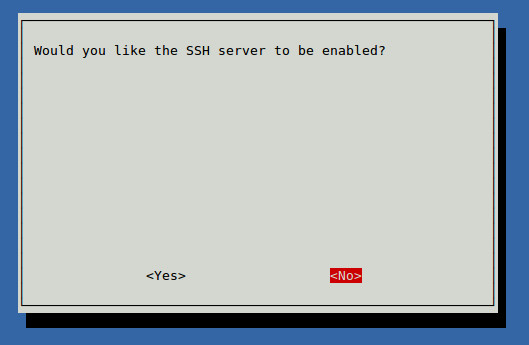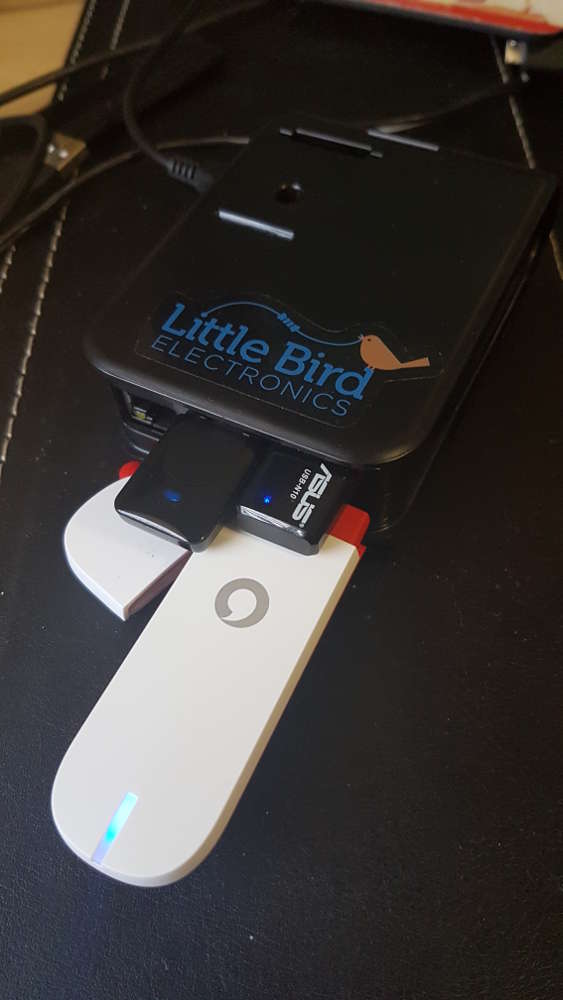Background/Overview:
My Wife and I like to travel overseas and we both have multiple devices when we travel. Over the years we’ve tried different solutions. From buying ‘travel’ sims before we leave that end up costing a fortune, to just enabling roaming on our phones and again, paying heavily for international data roaming.
After doing a little research on the best deal and wanting a flexible option, I bought a 3G dongle from Vodafone. A Huawei K4204 to be precise. My goal is to create a Raspberry Pi that will connect to the hotel WiFi when available and will have it’s own AP running on a different channel so that our devices only have to remember one Access Point. This will circumvent certain hotels that only allow you to connect a single device to their network. It will also mean that if we have a Google Chromecast I only have to program a single network into it and use it when we travel. The Raspberry Pi will have a 3G data connection when no Hotel WiFi is available or we’re out and about. When we arrive at our destination (the UK) we will buy a local sim with local (read: cheap) data.
The below steps are how I achieved the above:
Part 1: Initial Setup
Install Raspbian in any way you prefer. I’ve installed the lite version that has no gui.
Use dd to write to the disk, in my case the microSD card was at /dev/sdd:
sudo dd if=2017-04-10-raspbian-jessie-lite.img of=/dev/sdd bs=2M
log in as pi, password: raspberry
add a new user and add the user to the sudo group so you can edit system files:
sudo adduser wargus;sudo usermod -a -G sudo USERNAME
log in as your new user, remove pi
sudo deluser pi
enable ssh by default using raspi-config
sudo raspi-config
Under Interfacing Options, 2, Enable SSH:

Check the IP address of the raspberry pi, it should be set to dhcp automatically.
ifconfig eth0 Link encap:Ethernet HWaddr 00:00:00:00:00:00 inet addr:10.60.204.182 Bcast:10.60.204.255 Mask:255.255.255.128 UP BROADCAST RUNNING MULTICAST MTU:1500 Metric:1 RX packets:7511 errors:0 dropped:12 overruns:0 frame:0 TX packets:2759 errors:0 dropped:0 overruns:0 carrier:0 collisions:0 txqueuelen:1000 RX bytes:669438 (653.7 KiB) TX bytes:604742 (590.5 KiB)
At this point you can disconnect the terminal and use SSH to connect to your raspberry device.
Configuring usb_modeswitch
I used this site as a reference. It was mostly right for me, although I did have to do a lot troubleshooting before I had it completely right.
cd /tmp tar -xzvf /usr/share/usb_modeswitch/configPack.tar.gz 19d2\:1f1c
Will create a new file in the tmp directory it will need to be further edited to look like this:
# Vodafone / Huawei K4203 DefaultVendor=0x12d1 DefaultProduct=0x1f1c TargetVendor=0x12d1 TargetProductList="157a,1590" HuaweiNewMode=1
Copy or move that file to /etc/usb_modeswitch.d/
At this point with a fresh install, you should be able to plug in the dongle. Switch the usb mode by running :
sudo usb_modeswitch -c /etc/usb_modeswitch.d/12d1\:1f1c
Check the switch by using lsusb, as the output suggests.
lsusb Bus 001 Device 007: ID 12d1:1590 Huawei Technologies Co., Ltd. Bus 001 Device 004: ID 0bda:8178 Realtek Semiconductor Corp. RTL8192CU 802.11n WLAN Adapter Bus 001 Device 003: ID 0424:ec00 Standard Microsystems Corp. SMSC9512/9514 Fast Ethernet Adapter Bus 001 Device 002: ID 0424:9514 Standard Microsystems Corp. Bus 001 Device 001: ID 1d6b:0002 Linux Foundation 2.0 root hub
In my setup, the dongle flashed green, flashed blue, then goes solid blue. A quick check of ifconfig at this point shows that the dongle presents itself as a new Ethernet adaptor:
ifconfig ... eth1 Link encap:Ethernet HWaddr 00:00:00:00:00:00 inet addr:192.168.9.100 Bcast:192.168.9.255 Mask:255.255.255.0 UP BROADCAST RUNNING MULTICAST MTU:1500 Metric:1 RX packets:55 errors:0 dropped:0 overruns:0 frame:0 TX packets:38 errors:0 dropped:0 overruns:0 carrier:0 collisions:0 txqueuelen:1000 RX bytes:16310 (15.9 KiB) TX bytes:7400 (7.2 KiB)
The dongle automagically configures itself and connects to the internet. 🙂 Remember that at this point to connect to the internet will require you to manually set the dongle to the correct mode.
Test the connection by pinging over the interface:
ping www.google.com -I eth1 PING www.google.com (203.219.197.210) from 192.168.9.100 eth1: 56(84) bytes of data. 64 bytes from cache.google.com (203.219.197.210): icmp_seq=1 ttl=55 time=2254 ms 64 bytes from cache.google.com (203.219.197.210): icmp_seq=2 ttl=55 time=1248 ms 64 bytes from cache.google.com (203.219.197.210): icmp_seq=3 ttl=55 time=248 ms ping www.google.com -I eth0 PING www.google.com (203.219.197.245) from 10.60.204.182 eth0: 56(84) bytes of data. 64 bytes from cache.google.com (203.219.197.245): icmp_seq=1 ttl=60 time=1.85 ms 64 bytes from cache.google.com (203.219.197.245): icmp_seq=2 ttl=60 time=1.50 ms 64 bytes from cache.google.com (203.219.197.245): icmp_seq=3 ttl=60 time=2.33 ms
Part 2: Routing Configuration
At this point, we have a very smart little independently internet connected Raspberry Pi. What we want to do next is a little more complicated. We’re going to configure it to be an access point that will hand out IP addresses and handle NAT. unfortunately it won’t be smart enough to switch between wifi and 3G automatically however you can connect and do that yourself. 😉
Linux by default does not know that it is a router. We need to enable that functionality and, while we’re there, disable IPv6 (which is something of a security concern).
Edit /etc/sysctl.conf with your favourite editor and uncomment the line:
net.ipv4.ip_forward=1
Add the following lines:
net.ipv6.conf.all.disable_ipv6=1 net.ipv6.conf.default.disable_ipv6=1
Then run the following command to make the changes apply:
sudo sysctl -p
Install hostapd and configure your wifi dongle to be an access point:
sudo apt-get install hostapd -y
Edit the primary wifi dongle to be an access point by editing /etc/hostapd.conf
channel=3 country_code=AU hw_mode=g interface=wlan0 ssid=SSIDNAME wpa=2 wpa_key_mgmt= WPA-PSK WPA-EAP WPA-PSK-SHA256 WPA-EAP-SHA256 wpa_passphrase=PASSPHRASE
You will need to edit the above to suit. Be sure to check what channels are being used and pick one that does not have too much interference.
Now edit the /etc/network/interfaces file and change wlan0’s settings:
auto wlan0 allow-hotplug wlan0 iface wlan0 inet static hostapd /etc/hostapd/hostapd.conf address 10.60.205.129 netmask 255.255.255.128 broadcast 10.60.205.255 dns-nameservers 8.8.8.8 8.8.4.4
To save heartache later, edit the default settings for eth0 to:
iface eth0 inet dhcp
To explain the above: I’ve gone with a small 10.60.205.128/25 IP range and I’ve set google’s name servers to be my defaults. It is necessary to change eth0’s settings as it will fail to come up when we change some service settings below.
Finally, setup a dhcp server. I tend to prefer a more robust dhcp server:
sudo apt-get install isc-dhcp-server
Configure it to only operate on the wlan0 interface by editing /etc/default/isc-dhcp-server and changing the line INTERFACES=”” to
INTERFACES="wlan0"
Edit the configuration file for the dhcp server in /etc/dhcp/dhcpd.conf Change various options at the top to match your own configuration, the important points to recognise are:
# option definitions common to all supported networks...
option domain-name "yourdomain.local";
option domain-name-servers 8.8.8.8, 8.8.4.4;
subnet 10.60.205.128 netmask 255.255.255.128 {
range 10.60.205.150 10.60.205.190;
option routers 10.60.205.129;
option broadcast-address 10.60.205.255;
}
This will create a range of IP addresses to assign to devices as needed from 150 to 190. We still won’t have routing yet, but we’re nearly there! Enable the dhcp service:
sudo systemctl enable isc-dhcp-server.service
Start the dhcp server:
sudo service isc-dhcp-server start
It should be safe to start the service now, and test everything be restarting it. if you connect a device to the network it will be able to get an IP address, it just won’t have any internet access.
If you have another wifi dongle, as I do, it can also be configured to be a client to another wireless network. This is handy if your hotel only allows one device to be connected to their wifi and you have many devices. Connect the Raspberry Pi to their network and have it do NAT to your devices.
The Configuration at home may be different to the hotel, which is why I’ve included the note in the configuration below to remind me where to look for information. Remember, if you need to find more information you can always use the 3G dongle to get access to the internet 🙂
#Configure the roaming interface #Use 'sudo iwlist scan' to find an AP to join auto wlan1 allow-hotplug wlan1 iface wlan1 inet dhcp wpa-ssid SSID_OF_NETWORK wpa-psk PASSWORD
The Final Steps: Routing and Firewalling.
At this point we can write a simple script called firewall to allow routing. It can be placed in /etc/init.d/.
#!/bin/bash
# Iptables Location
IPTABLES="/sbin/iptables"
#Load Modules#
##########################################################
#
# Don't Touch anything below this line!
#
case "$1" in start)
echo "Starting Firewall Services"
echo "Firewall: Configuring firewall rules using iptables"
#BEGIN FIREWALL ROUTING HERE
#We want the 3G router to start when the firewall does. So we use usb switch here:
usb_modeswitch -c /etc/usb_modeswitch.d/12d1\:1f1c
#Flush Routing Table
$IPTABLES -F
$IPTABLES -t nat -F
$IPTABLES -t mangle -F
$IPTABLES -t mangle -X
$IPTABLES -X
# default policy
$IPTABLES -P INPUT ACCEPT
$IPTABLES -P FORWARD ACCEPT
$IPTABLES -P OUTPUT ACCEPT
# allow established,related
$IPTABLES -A INPUT -m state --state ESTABLISHED,RELATED -j ACCEPT
$IPTABLES -A FORWARD -m state --state ESTABLISHED,RELATED -j ACCEPT
# Masquerade over both routes
$IPTABLES -t nat -A POSTROUTING -o eth1 -j MASQUERADE
$IPTABLES -t nat -A POSTROUTING -o wlan1 -j MASQUERADE
#END FIREWALL ROUTING HERE
touch /var/lock/firewall
;;
status)
if [ -f /var/lock/firewall ]; then
echo "Firewall started and configured"
else
echo "Firewall stopped"
fi
exit 0
;;
restart|reload)
$0 stop
$0 start
;;
stop)
echo "Shutting down Firewall services"
#Flush Routing Table
$IPTABLES -F
$IPTABLES -t nat -F
$IPTABLES -t mangle -F
$IPTABLES -t mangle -X
$IPTABLES -X
# default policy
$IPTABLES -P INPUT ACCEPT
$IPTABLES -P FORWARD ACCEPT
$IPTABLES -P OUTPUT ACCEPT
rm -f /var/lock/firewall
echo
;;
*)
echo "Usage: /etc/init.d/firewall {start|stop|status|restart|reload}"
exit 1
esac
exit 0
I’ve noticed that by default the router will route traffic over the wlan1 before eth1, even if eth1 exists and has internet access. This is useful as it means that we can have a single firewall/routing script for both connections. It will fail-over to the 3G dongle when no appropriate WiFi AP can be found.
Install the script with:
sudo update-rc.d firewall defaults
At this point I was able to power down the Raspberry Pi. On coming back online the two dongles didn’t work, but the 3G dongle did. As hotplug is enabled on those two wifi dongles, removing and re-inserting them got them working again. I was then able to connect to the internet (and the Pi) over WiFi. Removing the dongle connecting to my home network immediately failed over to the 3G dongle.
Which brings us to the end!
